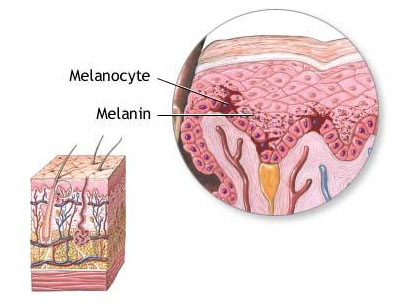Melanocyte
Melanocytes[edit]
Introduction[edit]
Melanocytes are specialized cells located in the skin and eyes, known for producing and containing the pigment melanin. This pigment is responsible for giving color to the skin, hair, and eyes, and plays a crucial role in protecting the skin from ultraviolet (UV) radiation.
Anatomy and Function[edit]
Location and Structure[edit]
Melanocytes are found in the epidermis, the outermost layer of the skin, and in the eye's uveal tract. They have long dendritic processes that extend to the surrounding keratinocytes, allowing the transfer of melanin.
Melanin Production[edit]
Melanin is synthesized within melanocytes through a process called melanogenesis. This process is influenced by genetic factors, exposure to sunlight, and hormonal changes.
Types of Melanin[edit]
There are two main types of melanin:
- Eumelanin: Provides brown to black pigment and offers protection against UV radiation.
- Pheomelanin: Gives a red or yellow color and is less effective in protecting against UV radiation.
Role in Skin Color and Sun Protection[edit]
Melanin's primary function is to absorb and dissipate UV radiation, protecting the DNA in skin cells from UV-induced damage. The amount and type of melanin determine an individual's skin color.
Melanocyte Disorders[edit]
Hyperpigmentation[edit]
Conditions like melasma or freckles are caused by increased melanin production.
Hypopigmentation[edit]
Conditions such as vitiligo and albinism result from reduced melanin production or absence of melanocytes.
Melanoma[edit]
Melanoma is a serious form of skin cancer that originates in melanocytes.
Diagnostic Methods[edit]
Melanocyte-related disorders are diagnosed using techniques such as:
- Dermatoscopy
- Skin biopsy
- Genetic testing (especially in cases of albinism)
Treatment and Management[edit]
Treatment depends on the specific condition and may include:
- Topical creams for hyperpigmentation
- Phototherapy for vitiligo
- Surgical and medical treatments for melanoma
References[edit]
<references>
</references>
External Links[edit]
Ad. Transform your life with W8MD's Budget GLP-1 injections from $75


W8MD offers a medical weight loss program to lose weight in Philadelphia. Our physician-supervised medical weight loss provides:
- Weight loss injections in NYC (generic and brand names):
- Zepbound / Mounjaro, Wegovy / Ozempic, Saxenda
- Most insurances accepted or discounted self-pay rates. We will obtain insurance prior authorizations if needed.
- Generic GLP1 weight loss injections from $75 for the starting dose.
- Also offer prescription weight loss medications including Phentermine, Qsymia, Diethylpropion, Contrave etc.
NYC weight loss doctor appointmentsNYC weight loss doctor appointments
Start your NYC weight loss journey today at our NYC medical weight loss and Philadelphia medical weight loss clinics.
- Call 718-946-5500 to lose weight in NYC or for medical weight loss in Philadelphia 215-676-2334.
- Tags:NYC medical weight loss, Philadelphia lose weight Zepbound NYC, Budget GLP1 weight loss injections, Wegovy Philadelphia, Wegovy NYC, Philadelphia medical weight loss, Brookly weight loss and Wegovy NYC
|
WikiMD's Wellness Encyclopedia |
| Let Food Be Thy Medicine Medicine Thy Food - Hippocrates |
Medical Disclaimer: WikiMD is not a substitute for professional medical advice. The information on WikiMD is provided as an information resource only, may be incorrect, outdated or misleading, and is not to be used or relied on for any diagnostic or treatment purposes. Please consult your health care provider before making any healthcare decisions or for guidance about a specific medical condition. WikiMD expressly disclaims responsibility, and shall have no liability, for any damages, loss, injury, or liability whatsoever suffered as a result of your reliance on the information contained in this site. By visiting this site you agree to the foregoing terms and conditions, which may from time to time be changed or supplemented by WikiMD. If you do not agree to the foregoing terms and conditions, you should not enter or use this site. See full disclaimer.
Credits:Most images are courtesy of Wikimedia commons, and templates, categories Wikipedia, licensed under CC BY SA or similar.
Translate this page: - East Asian
中文,
日本,
한국어,
South Asian
हिन्दी,
தமிழ்,
తెలుగు,
Urdu,
ಕನ್ನಡ,
Southeast Asian
Indonesian,
Vietnamese,
Thai,
မြန်မာဘာသာ,
বাংলা
European
español,
Deutsch,
français,
Greek,
português do Brasil,
polski,
română,
русский,
Nederlands,
norsk,
svenska,
suomi,
Italian
Middle Eastern & African
عربى,
Turkish,
Persian,
Hebrew,
Afrikaans,
isiZulu,
Kiswahili,
Other
Bulgarian,
Hungarian,
Czech,
Swedish,
മലയാളം,
मराठी,
ਪੰਜਾਬੀ,
ગુજરાતી,
Portuguese,
Ukrainian



